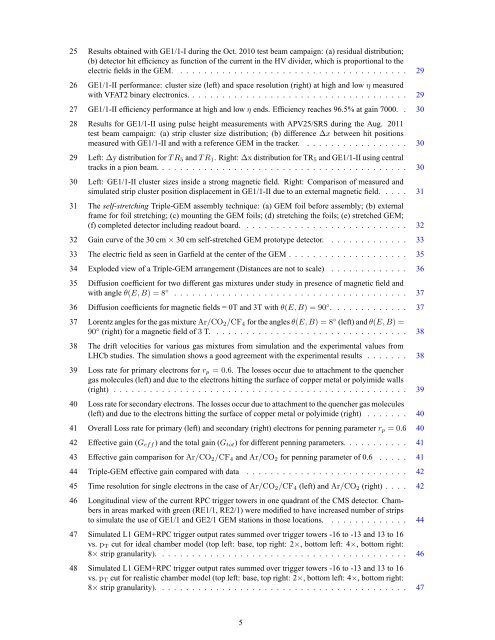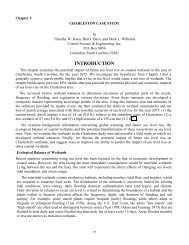A GEM Detector System for an Upgrade of the CMS Muon Endcaps
A GEM Detector System for an Upgrade of the CMS Muon Endcaps
A GEM Detector System for an Upgrade of the CMS Muon Endcaps
Create successful ePaper yourself
Turn your PDF publications into a flip-book with our unique Google optimized e-Paper software.
25 Results obtained with GE1/1-I during <strong>the</strong> Oct. 2010 test beam campaign: (a) residual distribution;<br />
(b) detector hit efficiency as function <strong>of</strong> <strong>the</strong> current in <strong>the</strong> HV divider, which is proportional to <strong>the</strong><br />
electric fields in <strong>the</strong> <strong>GEM</strong>. . . . . . . . . . . . . . . . . . . . . . . . . . . . . . . . . . . . . . . 29<br />
26 GE1/1-II per<strong>for</strong>m<strong>an</strong>ce: cluster size (left) <strong>an</strong>d space resolution (right) at high <strong>an</strong>d low η measured<br />
with VFAT2 binary electronics. . . . . . . . . . . . . . . . . . . . . . . . . . . . . . . . . . . . . 29<br />
27 GE1/1-II efficiency per<strong>for</strong>m<strong>an</strong>ce at high <strong>an</strong>d low η ends. Efficiency reaches 96.5% at gain 7000. . 30<br />
28 Results <strong>for</strong> GE1/1-II using pulse height measurements with APV25/SRS during <strong>the</strong> Aug. 2011<br />
test beam campaign: (a) strip cluster size distribution; (b) difference ∆x between hit positions<br />
measured with GE1/1-II <strong>an</strong>d with a reference <strong>GEM</strong> in <strong>the</strong> tracker. . . . . . . . . . . . . . . . . . 30<br />
29 Left: ∆y distribution <strong>for</strong>TR5 <strong>an</strong>dTR1. Right: ∆x distribution <strong>for</strong> TR5 <strong>an</strong>d GE1/1-II using central<br />
tracks in a pion beam. . . . . . . . . . . . . . . . . . . . . . . . . . . . . . . . . . . . . . . . . . 30<br />
30 Left: GE1/1-II cluster sizes inside a strong magnetic field. Right: Comparison <strong>of</strong> measured <strong>an</strong>d<br />
simulated strip cluster position displacement in GE1/1-II due to <strong>an</strong> external magnetic field. . . . . 31<br />
31 The self-stretching Triple-<strong>GEM</strong> assembly technique: (a) <strong>GEM</strong> foil be<strong>for</strong>e assembly; (b) external<br />
frame <strong>for</strong> foil stretching; (c) mounting <strong>the</strong> <strong>GEM</strong> foils; (d) stretching <strong>the</strong> foils; (e) stretched <strong>GEM</strong>;<br />
(f) completed detector including readout board. . . . . . . . . . . . . . . . . . . . . . . . . . . . 32<br />
32 Gain curve <strong>of</strong> <strong>the</strong> 30 cm × 30 cm self-stretched <strong>GEM</strong> prototype detector. . . . . . . . . . . . . . 33<br />
33 The electric field as seen in Garfield at <strong>the</strong> center <strong>of</strong> <strong>the</strong> <strong>GEM</strong> . . . . . . . . . . . . . . . . . . . . 35<br />
34 Exploded view <strong>of</strong> a Triple-<strong>GEM</strong> arr<strong>an</strong>gement (Dist<strong>an</strong>ces are not to scale) . . . . . . . . . . . . . 36<br />
35 Diffusion coefficient <strong>for</strong> two different gas mixtures under study in presence <strong>of</strong> magnetic field <strong>an</strong>d<br />
with <strong>an</strong>gle θ(E,B) = 8 ◦ . . . . . . . . . . . . . . . . . . . . . . . . . . . . . . . . . . . . . . . 37<br />
36 Diffusion coefficients <strong>for</strong> magnetic fields = 0T <strong>an</strong>d 3T withθ(E,B) = 90 ◦ . . . . . . . . . . . . . 37<br />
37 Lorentz <strong>an</strong>gles <strong>for</strong> <strong>the</strong> gas mixtureAr/CO2/CF4 <strong>for</strong> <strong>the</strong> <strong>an</strong>glesθ(E,B) = 8 ◦ (left) <strong>an</strong>dθ(E,B) =<br />
90 ◦ (right) <strong>for</strong> a magnetic field <strong>of</strong> 3 T. . . . . . . . . . . . . . . . . . . . . . . . . . . . . . . . . 38<br />
38 The drift velocities <strong>for</strong> various gas mixtures from simulation <strong>an</strong>d <strong>the</strong> experimental values from<br />
LHCb studies. The simulation shows a good agreement with <strong>the</strong> experimental results . . . . . . . 38<br />
39 Loss rate <strong>for</strong> primary electrons <strong>for</strong> rp = 0.6. The losses occur due to attachment to <strong>the</strong> quencher<br />
gas molecules (left) <strong>an</strong>d due to <strong>the</strong> electrons hitting <strong>the</strong> surface <strong>of</strong> copper metal or polyimide walls<br />
(right) . . . . . . . . . . . . . . . . . . . . . . . . . . . . . . . . . . . . . . . . . . . . . . . . . 39<br />
40 Loss rate <strong>for</strong> secondary electrons. The losses occur due to attachment to <strong>the</strong> quencher gas molecules<br />
(left) <strong>an</strong>d due to <strong>the</strong> electrons hitting <strong>the</strong> surface <strong>of</strong> copper metal or polyimide (right) . . . . . . . 40<br />
41 Overall Loss rate <strong>for</strong> primary (left) <strong>an</strong>d secondary (right) electrons <strong>for</strong> penning parameter rp = 0.6 40<br />
42 Effective gain (Geff ) <strong>an</strong>d <strong>the</strong> total gain (Gtot) <strong>for</strong> different penning parameters. . . . . . . . . . . 41<br />
43 Effective gain comparison <strong>for</strong> Ar/CO2/CF4 <strong>an</strong>d Ar/CO2 <strong>for</strong> penning parameter <strong>of</strong> 0.6 . . . . . 41<br />
44 Triple-<strong>GEM</strong> effective gain compared with data . . . . . . . . . . . . . . . . . . . . . . . . . . . 42<br />
45 Time resolution <strong>for</strong> single electrons in <strong>the</strong> case <strong>of</strong> Ar/CO2/CF4 (left) <strong>an</strong>d Ar/CO2 (right) . . . . 42<br />
46 Longitudinal view <strong>of</strong> <strong>the</strong> current RPC trigger towers in one quadr<strong>an</strong>t <strong>of</strong> <strong>the</strong> <strong>CMS</strong> detector. Chambers<br />
in areas marked with green (RE1/1, RE2/1) were modified to have increased number <strong>of</strong> strips<br />
to simulate <strong>the</strong> use <strong>of</strong> GE1/1 <strong>an</strong>d GE2/1 <strong>GEM</strong> stations in those locations. . . . . . . . . . . . . . 44<br />
47 Simulated L1 <strong>GEM</strong>+RPC trigger output rates summed over trigger towers -16 to -13 <strong>an</strong>d 13 to 16<br />
vs. pT cut <strong>for</strong> ideal chamber model (top left: base, top right: 2×, bottom left: 4×, bottom right:<br />
8× strip gr<strong>an</strong>ularity). . . . . . . . . . . . . . . . . . . . . . . . . . . . . . . . . . . . . . . . . . 46<br />
48 Simulated L1 <strong>GEM</strong>+RPC trigger output rates summed over trigger towers -16 to -13 <strong>an</strong>d 13 to 16<br />
vs.pT cut <strong>for</strong> realistic chamber model (top left: base, top right: 2×, bottom left: 4×, bottom right:<br />
8× strip gr<strong>an</strong>ularity). . . . . . . . . . . . . . . . . . . . . . . . . . . . . . . . . . . . . . . . . . 47<br />
5
















